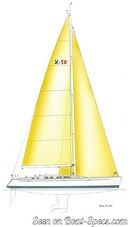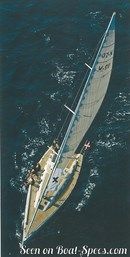X-50 Shoal draft
Sailboat specifications
The X-50 is a 50’ (15.24m) racer-cruiser sailboat designed by Niels Jeppesen (Denmark). She was built between 2004 and 2011 by X-Yachts (Denmark) with 63 hulls completed. The Shoal draft version features a shorter keel to grant access to shallow areas.
The X-50 is as well listed, on Boat-Specs.com, in Standard version (see all the versions compared).
The X-50 is as well listed, on Boat-Specs.com, in Standard version (see all the versions compared).
X-50's main features
- Model
- X-50
- Version
- Shoal draft
- Hull type
- Monohull
- Category
- Offshore racer-cruiser sailboat
- Sailboat builder
- Sailboat designer
- Country
- Denmark
- Construction
- GRP (glass reinforced polyester):
Sandwich fiberglass polyester with galvanized steel frame - Number of hulls built
- 63
- First built hull
- 2004
- Last built hull
- 2011
- Appendages
- Keel : L-shaped keel (with bulb)
- Helm
- Twin helm wheels
- Rudder
- Single spade rudder
- Unsinkable
- No
- Trailerable
- No
- EC design categoryiThe CE design category indicates the ability to cope with certain weather conditions (the sailboat is designed for these conditions)
A: Wind < force 9, Waves < 10m
B: Wind < force 8, Waves < 8m
C: Wind < force 6, Waves < 4m
D: Wind < force 4, Waves < 0,5m - A
- Standard public price ex. VAT (indicative only)
- N/A €
X-50's main dimensions
- Hull length
- 50’15.24 m
- Waterline length
- 43’ 1”13.14 m
- Beam (width)
- 14’4.28 m
- Waterline beam (width)
- 11’ 11”3.63 m
- Draft
- 7’ 11”2.4 m
- Light displacement (MLC)
- 27337 lb12400 kg
- Ballast weight
- 10935 lb4960 kg
- Ballast type
- Cast iron / lead fin
X-50's rig and sails
- Upwind sail area
- 1667 ft²154.9 m²
- Downwind sail area
- 2921 ft²271.4 m²
- Mainsail area
- 829 ft²77 m²
- Genoa area
- 839 ft²77.9 m²
- Solent area
- 671 ft²62.3 m²
- Jib area
- 554 ft²51.5 m²
- Symmetric spinnaker area
- 2093 ft²194.4 m²
- Rigging type
- Sloop Marconi 9/10
- Mast configuration
- Keel stepped mast
- Rotating spars
- No
- Number of levels of spreaders
- 3
- Spreaders angle
- Swept-back
- Spars construction
- Aluminum spars (carbon fiber spars as an option)
- Standing rigging
- Single-strand (ROD)
X-50's performances
- Upwind sail area to displacementiThe ratio sail area to displacement is obtained by dividing the sail area by the boat's displaced volume to the power two-thirds.
The ratio sail area to displacement can be used to compare the relative sail plan of different sailboats no matter what their size.
Upwind: under 18 the ratio indicates a cruise oriented sailboat with limited performances especially in light wind, while over 25 it indicates a fast sailboat. - 311 ft²/T28.91 m²/T
- Downwind sail area to displacementiThe ratio sail area to displacement is obtained by dividing the sail area by the boat's displaced volume to the power two-thirds.
The ratio sail area to displacement can be used to compare the relative sail plan of different sailboats no matter what their size. - 545 ft²/T50.66 m²/T
- Displacement-length ratio (DLR)iThe Displacement Length Ratio (DLR) is a figure that points out the boat's weight compared to its waterline length. The DLR is obtained by dividing the boat's displacement in tons by the cube of one one-hundredth of the waterline length (in feet).
The DLR can be used to compare the relative mass of different sailboats no matter what their length:
a DLR less than 180 is indicative of a really light sailboat (race boat made for planning), while a DLR greater than 300 is indicative of a heavy cruising sailboat. - 155
- Ballast ratioiThe Ballast ratio is an indicator of stability; it is obtained by dividing the boat's displacement by the mass of the ballast. Since the stability depends also of the hull shapes and the position of the center of gravity, only the boats with similar ballast arrangements and hull shapes should be compared.
The higher the ballast ratio is, the greater is the stability. - 40 %
- Critical hull speediAs a ship moves in the water, it creates standing waves that oppose its movement. This effect increases dramatically the resistance when the boat reaches a speed-length ratio (speed-length ratio is the ratio between the speed in knots and the square root of the waterline length in feet) of about 1.2 (corresponding to a Froude Number of 0.35) . This very sharp rise in resistance, between speed-length ratio of 1.2 to 1.5, is insurmountable for heavy sailboats and so becomes an apparent barrier. This leads to the concept of "hull speed".
The hull speed is obtained by multiplying the square root of the waterline length (in feet) by 1.34. - 8.80 knots
X-50's auxiliary engine
- Engine(s)
- 1 inboard engine
- Engine(s) power
- 75 HP
- Fuel type
- Diesel
X-50's accommodations and layout
- Cockpit
- Open aft cockpit
- Cabin(s) (min./max.)
- 3 / 4
- Berth(s) (min./max.)
- 6 / 8
- Head(s)
- 3








X-Yachts X-50 interior and accommodations - - 7/7
Picture extracted from the commercial documentation © X-Yachts
Picture extracted from the commercial documentation © X-Yachts
Similar sailboats that may interest you:
Sailboats
First built hull
Hull length
2009
44’ 4”13.5 m
2014
45’ 10”13.95 m
2012
46’ 7”14.2 m
2008
46’ 2”14.08 m
2004
48’ 11”14.9 m
1988
52’ 6”16 m
2004
50’15.24 m
2002
45’ 1”13.75 m
2005
55’16.76 m
2010
49’ 2”14.99 m
2012
49’ 2”14.99 m
2004
40’12.19 m
2000
52’ 6”16 m
2017
50’ 11”15.51 m
2016
46’ 2”14.09 m